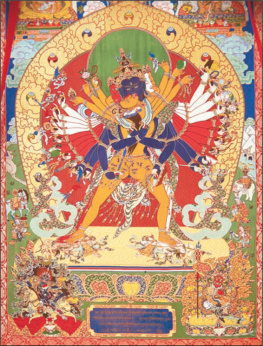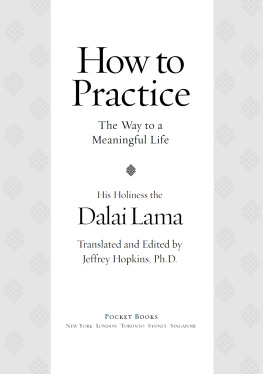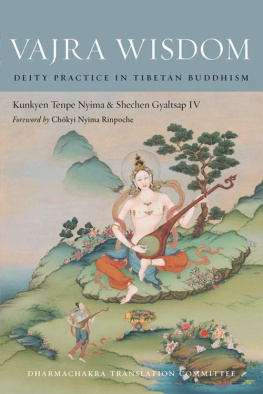Contents
The Great Exposition of Secret Mantra
VOLUME ONE
Tantra in Tibet
VOLUME TWO
Deity Yoga
VOLUME THREE
Yoga Tantra
Snow Lion
An imprint of Shambhala Publications, Inc.
4720 Walnut Street
Boulder, Colorado 80301
www.shambhala.com
1981 by George Allen & Unwin Ltd.
Revisions to original edition 2017 by Jeffrey Hopkins
First published as The Yoga of Tibet by George Allen & Unwin Ltd., London, England, 1981, and previously published as Deity Yoga by arrangement with Unwin & Hyman Ltd., 1987. Some spellings and portions of the translation have been updated.
All rights reserved. No part of this book may be reproduced in any form or by any means, electronic or mechanical, including photocopying, recording, or by any information storage and retrieval system, without permission in writing from the publisher.
Cover art: Thangka with scenes from the life of the Tibetan pundit Tsongkhapa. Tibet, 19th century: Museum der Kulturen Basel, IId 13771, Essen Collection. Photo: Omar Lemke, 2016. Museum der Kulturen Basel. All rights reserved.
Cover design: Gopa & Ted2, Inc.
Revised edition
Library of Congress Cataloging-in-Publication Data
Names: Bstan-dzin-rgya-mtsho, Dalai Lama XIV, 1935 author. | Tsong-kha-pa Blo-bzang-grags-pa, 13571419, author. | Hopkins, Jeffrey, translator, editor.
Title: The Great Exposition of Secret Mantra / The Dalai Lama, Tsongkhapa; translated and edited by Jeffrey Hopkins.
Description: Boulder, Colorado: Snow Lion, 20162017. | Includes bibliographical references and index. Contents: volume 1. Tantra in Tibet volume 2. Deity Yoga volume 3. Yoga Tantra. | Includes translations from Tibetan.
Identifiers: LCCN 2016000757| ISBN 9781611803594 ( V . 1) | ISBN 9781611803587 ( V . 2) | ISBN 9781611803600 ( V . 3)
eISBN9780834840690
Subjects: LCSH: Tantric Buddhism. | Buddhist mantras. | BISAC: RELIGION / Buddhism / Tibetan. | RELIGION / Buddhism / Rituals & Practice.
Classification: LCC BQ 7935. B 774 G 74 2016 | DDC 294.3/444dc23
LC record available at https://lccn.loc.gov/2016000757
v4.1
a
P REFACE
Homage to Vajradhara.
This book is a continuation of Tantra in Tibet. Centered on the second and third parts of Tsongkhapas The Great Exposition of Secret Mantra, it presents the profound process of meditation in Action and Performance Tantra. Tsongkhapa lays out the procedure of practice in Action Tantra, mainly combining the expositions in two tantrasthe Susiddhi Tantra also detail the preliminary rites, the pledges, and so forth. Almost all of Tsongkhapas presentation can be found in these four texts; his creative innovation is to interweave them into a complete system of practice of this class of tantra.
Tsongkhapas brief exposition of Performance Tantra, which is drawn only from the Vairochanbhisambodhi Tantra and Buddhaguhyas two commentaries on it, present the yoga with signs, which has both external and internal versions of the four-branched repetition, and then the yoga without signs. The brevity is likely due to the length and complexity of the exposition of Action Tantra, whose meditation has many similarities. These explanations of the extraordinary features of the Action Tantra path and of an outline of Performance Tantra system illustrate the immense psychological complexity of the tantric path and also lay the groundwork for those who wish to cultivate these tantras upon receiving initiation from a qualified lama.
Part I is an introduction by His Holiness the Dalai Lama, whose commentary on Tsongkhapas text I received in 1974 and subsequently translated and edited. His lucid exposition of the complex meditative rites of deity yogathe distinctly tantric process in which a yogi cultivates imaginative appearance in a Buddhas divine bodyaffords an accessibility to Part II, Tsongkhapas text itself. Part III is a supplement primarily on the structure of the path in Action Tantra. In addition to the first two parts of this book, it is drawn from:
Butns Extensive General Presentation of the Tantra Sets
Khaydrub Geleg Palsangs Extensive Explanation of the Format of the General Tantra Sets
Duldzin Dragpa Gyaltshans Presentation of the General Rites of Action and Performance Tantra and Their Application to the Three Lineages, Set Down by Duldzin According to the Foremost [Tsongkhapas] Practice
Bodong Choglay Namgyals General Presentation of Action Tantra
Pachen Snam Dragpas General Presentation of the Tantra Sets: Captivating the Minds of the Fortunate
Yeshay Gyaltshans Illumination of the Meaning of Action Tantra
Ngagwang Paldans Presentation of the Grounds and Paths of Mantra
the oral teachings of Lati Jangchub Tshultrim Rinpoche, philosophy master and tantric lama who served as abbot of the Shartse College of Gandan Monastery in Mundgod, Karnataka State, India
the oral teachings of Danma Loch Rinpoche, philosophy master and tantric lama who served as abbot of the Tibetan Monastery at Kulu and later as the abbot of Namgyal Monastery in Dharmsala, India
Based on Tsongkhapas remark at end of the chapter on Action Tantra:
If one propounds to know the meaning of Action and Performance Tantras
By knowing a portion of their meditations and repetitions
Such as rites of fasting, bathing, and so forth, it is a source of laughter.
Therefore, cherish arrangement of the tantra meanings into paths.
it is easily seen that Tsongkhapas chief aim is go beyond the often reduction of Action Tantra to mere rituals for fasting, bathing, and the like and present the entire scope of the general Action Tantra meditation beginning with the preparatory rituals and extending through the elaborate and very rich meditative practices that culminate with the achievement of yogic feats and the progress along the spiritual path. Since he does this with careful citation of sources of tantras and Indian commentaries, I have sought in this edition of the book to put more focus on the practical implementation of his ingenious amalgamation of sources by putting these practical instructions in a Means of Achievement (sgrub thabs, sdhana). It is found after an introduction about the structure of the path in the second chapter of the Supplement.
I orally retranslated Tsongkhapas text into Tibetan for the late Lati Jangchub Tshultrim Rinpoche, who knew almost no English, for the sake of correction and verification, and I received a complete commentary of Tsongkhapas text from the late Danma Loch Rinpoche. Dr. Elizabeth Napper, then a doctoral candidate in Buddhist Studies at the University of Virginia, provided crucial help in editing the entire manuscript. A guide to Tsongkhapas text, following his own mode of division of the contents, is given in tabular form in an appendix.













